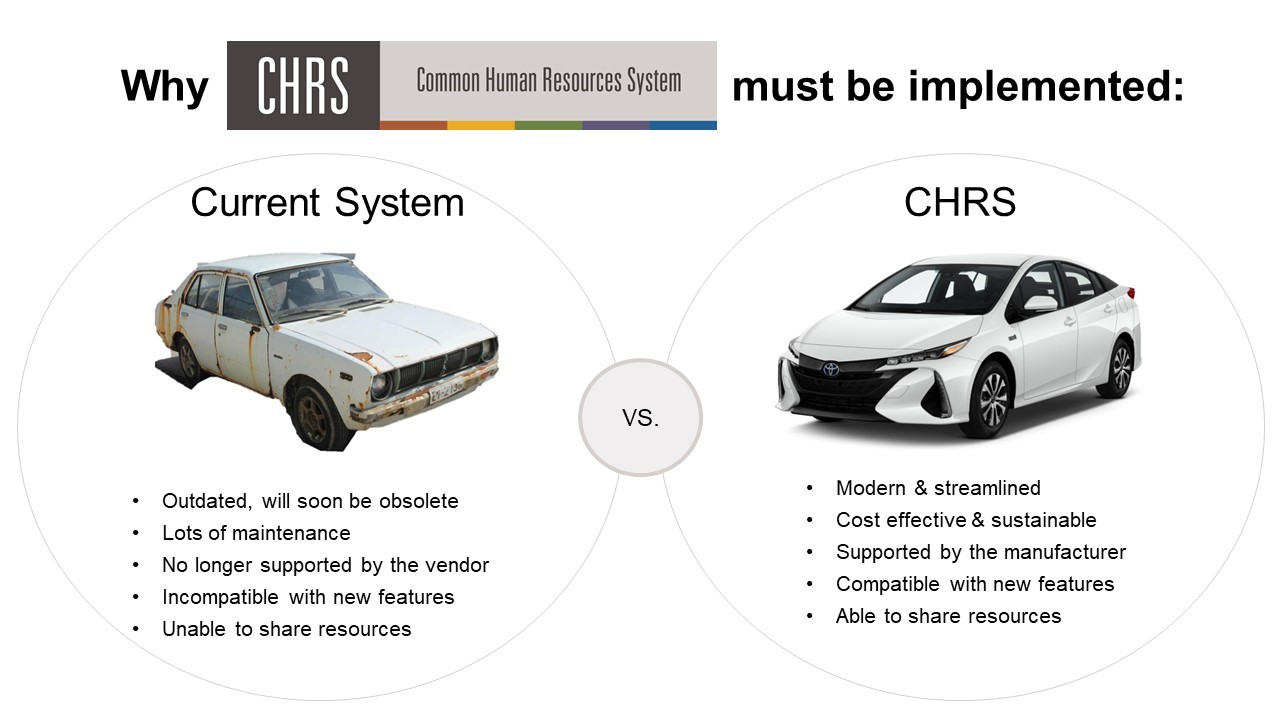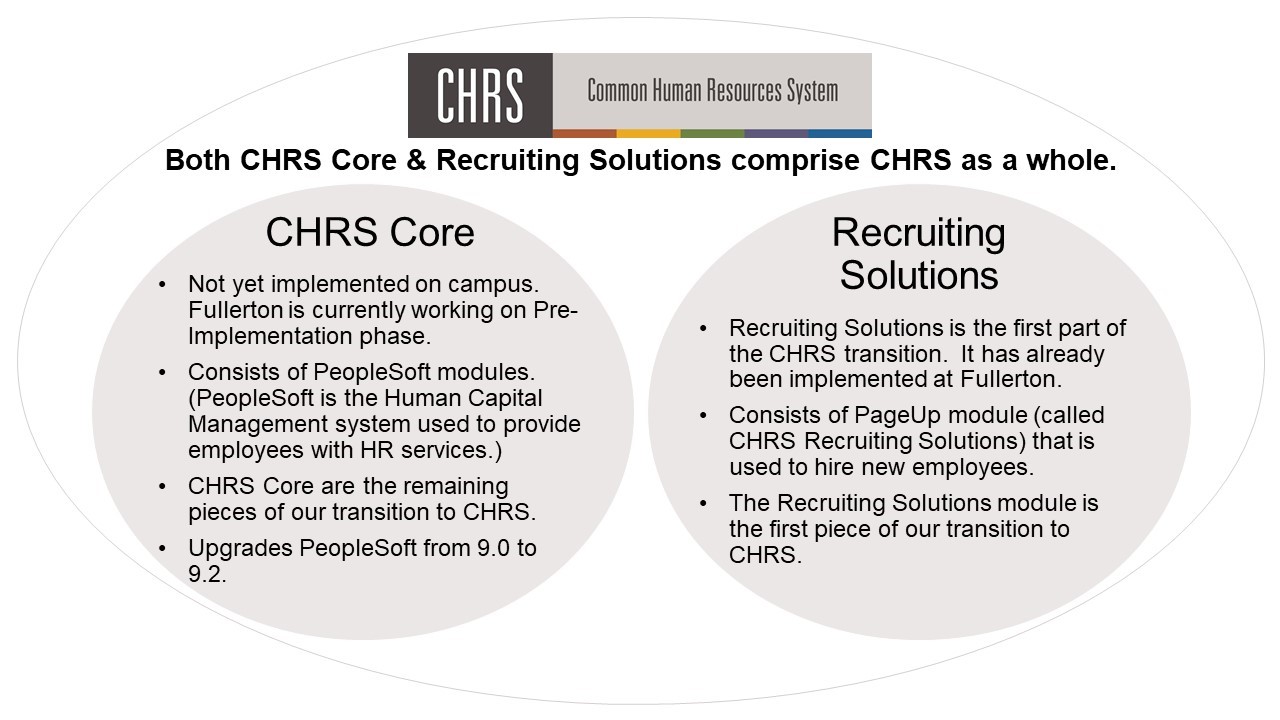
FAQs
What is CHRS?
Cal State Fullerton has been selected by the Chancellor’s Office to be an early adopter of the Common Human Resources System (CHRS). CHRS will create a single Human Resources platform for all 23 campuses in the California State University system.
Currently, the CSU uses 23 different versions of software across the system, which is difficult and costly to maintain. CHRS will consolidate the entire CSU to a single HR system (PeopleSoft 9.2) and shared HR database. All 23 campuses and the CO will be united by using one, standardized HR platform. Once implemented, this common system and database will provide the CSU with opportunities for better communication, enhanced technology, and easier sharing of knowledge and resources between campuses.
As early adopters, Cal State Fullerton and Stanislaus State will be the first campuses to implement CHRS and benefit from these improvements.
What is the difference between a CHRS Employee ID (Empl ID) and a Campus-Wide ID (CWID)?
- The CHRS Empl ID refers to a specific CSU identification number that is used in CHRS.
- In CHRS, every employee has a 9-digit EmplID that serves as a permanent, unique identifier for the CSU.
- For example, if employee Tuffy Titan works at CSUF and receives CHRS EmplID 123456789, then Tuffy will always have that EmplID no matter what campus they work at. If Tuffy were to start work at CSU Stanislaus campus, their CHRS EmplID would still be 123456789.
- The Campus-Wide ID (CWID) refers to our campus-issued identification number.
- The CWID is used as an identifier in our other systems (Campus Solutions, etc.).
- The CWID is a 9-digit number that starts with an 8.
- Each campus has their own CWID.
Why is there a CHRS EmplID?
Since all 23 CSU campuses and the Chancellor’s Office will share a single HR employment system (CHRS), it is necessary for every single CSU employee to have their own unique identifier in the new, upgraded system. (Campus-wide ID numbers overlap from campus to campus, so using CWID’s was not an option.)
Why is the CSU implementing CHRS?
Our current system (PeopleSoft 9.0) lacks a systemwide mobile interface, advanced, standardized data reporting, and is no longer supported by the vendor. CHRS will solve these problems by upgrading our system to the latest PeopleSoft 9.2 functionality. It is necessary to make this change now because our current system is rapidly approaching obsolescence. To learn more about why CHRS is being rolled out, watch this short video or view the graphic below:

Why is CHRS a priority for the CSU?
CHRS will vastly improve the CSU’s HR data. With access to better, standardized data, both campuses and systemwide HR can make better, data-driven decisions.
On the campus level, CHRS data will help HRDI perform data analysis to understand the impact of its policies. This analysis can be used to improve the Titan experience and institute policies specifically tailored to our needs. CHRS will be a robust tool used to strengthen our institutional effectiveness.
Streamlining our system and having standardized HR data for all campuses has been a goal of the CSU for years. With CHRS, the CSU will realize that goal!
What does CHRS mean for me?
When CHRS is launched, our employees will enjoy more self-service options. Titans will be able to access their upgraded, mobile-friendly employee self-service. Current PeopleSoft users will find a streamlined look and feel with an easily navigable interface. Certain HR transactions may be processed differently to meet the needs of the CSU and standardized CHRS system. There will be some growing pains as we all adjust to a new HR system, but the gains and efficiencies are expected to far outweigh the short-term learning curve.
When will CHRS be launched?
Current timelines show CHRS going live in Fall 2023. The Chancellor’s Office and selected campuses Cal State Fullerton and Stanislaus State have already begun to collaborate on the CHRS project. At the beginning of March 2020, a team of experts from each campus met with the Chancellor’s Office to lay the groundwork for CHRS implementation.
The Pre-Implementation phase takes place throughout 2020, with HR and IT divisions preparing for CHRS. CHRS will be finalized throughout 2021, with system testing taking place throughout 2022. CHRS is anticipated to be implemented and launched during Fall 2023. (Refer to the Timeline section of our CHRS website.)
Who is working on CHRS and how will campus be updated?
Fullerton’s HR and IT Divisions are already hard at work preparing for CHRS implementation. Both divisions will involve others as needed, providing training and other necessary materials to navigate the new system.
CHRS communication updates will be sent to keep our campus informed of the project’s progress. Campus updates will most frequently be provided by HR’s VP David Forgues, Fullerton’s Primary Sponsor of the CHRS Project. Click on the Team Members page of the CHRS website for more details.
What is CHRS vs. CHRS Recruiting Solutions?
CHRS Recruiting Solutions is the first CHRS module that was implemented on Fullerton’s campus. Recruiting Solutions is used to hire employees. The remaining CHRS modules are part of PeopleSoft and deal with managing employees and their HR needs. CHRS Recruiting Solutions replaced Brassring as our hiring system, whereas CHRS replaces our HR Human Capital Management system (PeopleSoft 9.0) with a newer version (PeopleSoft 9.2).
CHRS Recruiting Solutions is sometimes shortened to “Recruiting” or “CHRS Recruiting.” CHRS Core is sometimes used to refer to the PeopleSoft 9.2 part of the project.
This diagram will help clarify:

Where can I get more information?
For more information on the CHRS Program, please visit the CSU’s CHRS Website or contact chrs@fullerton.edu.
